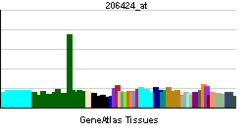CYP26A1
Cytochrome P450 26A1 is a protein that in humans is encoded by the CYP26A1 gene.[1][2][3]
This gene encodes a member of the cytochrome P450 superfamily of enzymes. The cytochrome P450 proteins are monooxygenases which catalyze many reactions involved in drug metabolism and synthesis of cholesterol, steroids and other lipids. This endoplasmic reticulum protein acts on retinoids, including all-trans-retinoic acid (RA), with both 4-hydroxylation and 18-hydroxylation activities. This enzyme regulates the cellular level of retinoic acid which is involved in regulation of gene expression in both embryonic and adult tissues. Two alternatively spliced transcript variants of this gene, which encode the distinct isoforms, have been reported.[3]
CYP26A1 is over-expressed in colorectal cancer cells compared to normal colonic epithelium but is of no independent prognostic value in patients with colorectal cancer.[4]
References
- ↑ White JA, Beckett-Jones B, Guo YD, Dilworth FJ, Bonasoro J, Jones G, Petkovich M (Sep 1997). "cDNA cloning of human retinoic acid-metabolizing enzyme (hP450RAI) identifies a novel family of cytochromes P450". J Biol Chem 272 (30): 18538–41. doi:10.1074/jbc.272.30.18538. PMID 9228017.
- ↑ White JA, Beckett B, Scherer SW, Herbrick JA, Petkovich M (Jun 1998). "P450RAI (CYP26A1) maps to human chromosome 10q23-q24 and mouse chromosome 19C2-3". Genomics 48 (2): 270–2. doi:10.1006/geno.1997.5157. PMID 9521883.
- ↑ 3.0 3.1 "Entrez Gene: CYP26A1 cytochrome P450, family 26, subfamily A, polypeptide 1".
- ↑ Brown, Gordon; Beatriz Cash; Daniela Blihoghe; Petronella Johansson; Ayham Alnabulsi; Graeme Murray (2014-03-07). "The Expression and Prognostic Significance of Retinoic Acid Metabolising Enzymes in Colorectal Cancer". PLOS ONE. doi:10.1371/journal.pone.0090776.
Further reading
- Duell EA, Kang S, Voorhees JJ (1996). "Retinoic acid isomers applied to human skin in vivo each induce a 4-hydroxylase that inactivates only trans retinoic acid". J. Invest. Dermatol. 106 (2): 316–20. doi:10.1111/1523-1747.ep12342972. PMID 8601734.
- Ray WJ, Bain G, Yao M, Gottlieb DI (1997). "CYP26, a novel mammalian cytochrome P450, is induced by retinoic acid and defines a new family". J. Biol. Chem. 272 (30): 18702–8. doi:10.1074/jbc.272.30.18702. PMID 9228041.
- Sonneveld E, van den Brink CE, van der Leede BM et al. (1998). "Human retinoic acid (RA) 4-hydroxylase (CYP26) is highly specific for all-trans-RA and can be induced through RA receptors in human breast and colon carcinoma cells". Cell Growth Differ. 9 (8): 629–37. PMID 9716180.
- Trofimova-Griffin ME, Juchau MR (1998). "Expression of cytochrome P450RAI (CYP26) in human fetal hepatic and cephalic tissues". Biochem. Biophys. Res. Commun. 252 (2): 487–91. doi:10.1006/bbrc.1998.9659. PMID 9826557.
- Popa C, Dicker AJ, Dahler AL, Saunders NA (2000). "Cytochrome P450, CYP26AI, is expressed at low levels in human epidermal keratinocytes and is not retinoic acid-inducible". Br. J. Dermatol. 141 (3): 460–8. doi:10.1046/j.1365-2133.1999.03039.x. PMID 10583049.
- McSorley LC, Daly AK (2000). "Identification of human cytochrome P450 isoforms that contribute to all-trans-retinoic acid 4-hydroxylation". Biochem. Pharmacol. 60 (4): 517–26. doi:10.1016/S0006-2952(00)00356-7. PMID 10874126.
- Loudig O, Babichuk C, White J et al. (2001). "Cytochrome P450RAI(CYP26) promoter: a distinct composite retinoic acid response element underlies the complex regulation of retinoic acid metabolism". Mol. Endocrinol. 14 (9): 1483–97. doi:10.1210/me.14.9.1483. PMID 10976925.
- Deng L, Shipley GL, Loose-Mitchell DS et al. (2003). "Coordinate regulation of the production and signaling of retinoic acid by estrogen in the human endometrium". J. Clin. Endocrinol. Metab. 88 (5): 2157–63. doi:10.1210/jc.2002-021844. PMID 12727970.
- Ota T, Suzuki Y, Nishikawa T et al. (2004). "Complete sequencing and characterization of 21,243 full-length human cDNAs". Nat. Genet. 36 (1): 40–5. doi:10.1038/ng1285. PMID 14702039.
- Won JY, Nam EC, Yoo SJ et al. (2004). "The effect of cellular retinoic acid binding protein-I expression on the CYP26-mediated catabolism of all-trans retinoic acid and cell proliferation in head and neck squamous cell carcinoma". Metab. Clin. Exp. 53 (8): 1007–12. doi:10.1016/j.metabol.2003.12.015. PMID 15281009.
- Loudig O, Maclean GA, Dore NL et al. (2006). "Transcriptional co-operativity between distant retinoic acid response elements in regulation of Cyp26A1 inducibility". Biochem. J. 392 (Pt 1): 241–8. doi:10.1042/BJ20050874. PMC 1317683. PMID 16053444.
- Ozpolat B, Mehta K, Lopez-Berestein G (2005). "Regulation of a highly specific retinoic acid-4-hydroxylase (CYP26A1) enzyme and all-trans-retinoic acid metabolism in human intestinal, liver, endothelial, and acute promyelocytic leukemia cells". Leuk. Lymphoma 46 (10): 1497–506. doi:10.1080/10428190500174737. PMID 16194896.
- Heise R, Mey J, Neis MM et al. (2007). "Skin retinoid concentrations are modulated by CYP26AI expression restricted to basal keratinocytes in normal human skin and differentiated 3D skin models". J. Invest. Dermatol. 126 (11): 2473–80. doi:10.1038/sj.jid.5700432. PMID 16778795.
- Rat E, Billaut-Laden I, Allorge D et al. (2006). "Evidence for a functional genetic polymorphism of the human retinoic acid-metabolizing enzyme CYP26A1, an enzyme that may be involved in spina bifida". Birth Defects Res. Part a Clin. Mol. Teratol. 76 (6): 491–8. doi:10.1002/bdra.20275. PMID 16933217.
- Gomaa MS, Yee SW, Milbourne CE et al. (2007). "Homology model of human retinoic acid metabolising enzyme cytochrome P450 26A1 (CYP26A1): active site architecture and ligand binding". J Enzyme Inhib Med Chem 21 (4): 361–9. doi:10.1080/14756360600742014. PMID 17059167.
- Quere R, Baudet A, Cassinat B et al. (2007). "Pharmacogenomic analysis of acute promyelocytic leukemia cells highlights CYP26 cytochrome metabolism in differential all-trans retinoic acid sensitivity". Blood 109 (10): 4450–60. doi:10.1182/blood-2006-10-051086. PMID 17218384.
- Lee SJ, Perera L, Coulter SJ et al. (2007). "The discovery of new coding alleles of human CYP26A1 that are potentially defective in the metabolism of all-trans retinoic acid and their assessment in a recombinant cDNA expression system". Pharmacogenet. Genomics 17 (3): 169–80. doi:10.1097/FPC.0b013e32801152d6. PMC 2393551. PMID 17460545.
| ||||||||||||||||||||||||||
